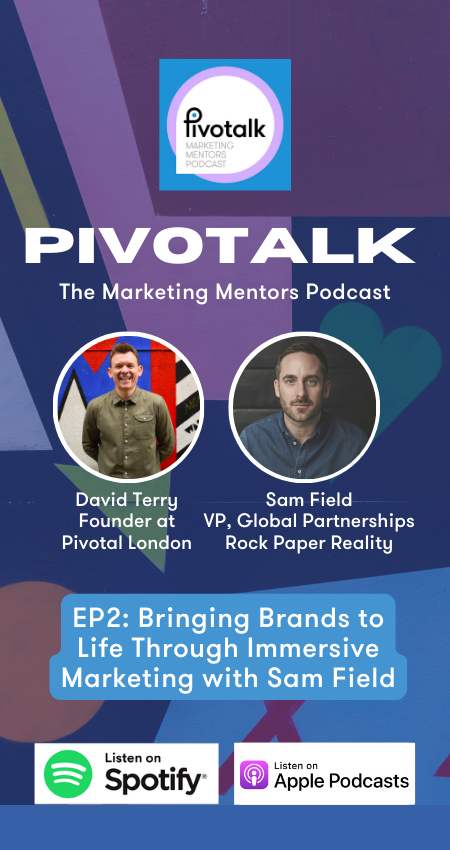Immersive Marketing in the Age of Attention Scarcity
20th May 2025
In a hyper-distracted world, catching – and keeping – someone’s attention is no easy task. As marketers compete for increasingly fragmented attention, the rules of engagement have changed, and static banners, skippable videos, and generic messaging won't cut it.
So, what does, and how do you stop the scroll?
According to Sam Field, VP of Global Partnerships at immersive agency Rock Paper Reality, the answer lies in a marketing approach where people are no longer passive viewers, but active participants.
“The number one reason that brands use [immersive marketing] is about engagement, attention,” Sam explained on Pivotalk. “You have a format or an experience that their audiences are actively choosing to engage with.”
In this blog, we explore Sam’s thoughts on how immersive content addresses attention scarcity, and why it’s a tool brands need right now.
Why Passive Formats Are Losing Ground
Social media ‘vanity’ metrics like impressions, short views, fleeting likes are nice, but don’t always represent real engagement.
Sam points out that immersive formats flip this dynamic on its head. Instead of measuring a view that lasts “one second, like some social metrics,” immersive experiences create deeper, voluntary participation.
“Because of that, [consumers are] more likely to remember it as an experience… they’re actively choosing to go and engage with it. The way the brain imprints on it is that it’s something they did.”
That distinction — from passively watching to actively doing — is what makes immersive storytelling so effective in today’s market.
What Makes Immersive Marketing Work?
Immersive marketing isn’t about flashy tech for the sake of it. It’s about experiences that invite interaction, presence, and emotion.
As Sam puts it: “Immersive marketing is about putting the customer or the user at the centre of the story. They need to have presence… feel like they have agency over the outcome.”
This approach taps into a different part of the brain, one that doesn’t just consume, but remembers. And in a noisy marketing world, that memory is priceless.
Where Immersive Marketing is Delivering Value
With immersive marketing, brands are already seeing tangible results.
One standout example Sam shared was a collaboration with Saatchi Art. Using augmented reality, Rock Paper Reality helped customers visualise 1.4 million pieces of art in their own homes:
“We saw bigger basket sizes, we saw bigger conversion rates. All of the metrics they wanted to see went up because of that.”
This is a powerful reminder that immersive marketing isn’t just a creative play, it serves as a performance driver too.
What’s Fuelling AR and AI Adoption
From Google’s AR integrations to Meta’s Ray-Ban smart glasses, immersive tech is rapidly becoming more accessible. But what’s especially powerful is the convergence of AR and AI, something Sam believes will herald the next wave of consumer engagement.
“With any emerging tech, what makes it exciting is when the technologies converge… so the idea that you've got this kind of multimodal AI in your glasses or headset that can see what you're seeing and contextualise it — that is a really useful application”
The idea isn’t far off: location-based AR, AI-enhanced wearables, and conversational interfaces that know what you’re looking at. When immersive tools get smart, they get sticky.
Why Story Still Comes First
But with all this new tech, Sam is clear on one thing: don’t start with the format.
“Technology shouldn't come first. Stories should come first. What you want your audiences to do, think, feel should come before the technology.”
At Rock Paper Reality, this principle is baked into their process. Before any AR, AI, or XR is introduced, they ask: is immersive the right solution for this brand, this campaign, this audience?
“Sometimes immersive isn't the answer. We’ve got a team of strategists to help with the strategy side of what customers want.”
That mindset helps filter hype from opportunity, ensuring immersive is an effective and exciting solution.
Final Word
As attention becomes more fragmented, the brands that win will be the ones that create memorable, useful, emotional moments. Immersive marketing, done well, is one of the few tools that can do all three.
“Are you looking to invest in the future of the way people will engage with your brand?” Sam asks. “Because we are seeing big growth in XR wearables, in AR technology, in different touchpoints, different platforms.”
The key to good marketing isn’t just about being seen, it’s about being remembered, and immersive can help brands achieve this.
Listen to the full episode of Pivotalk with Sam Field here:
https://www.pivotallondon.co.uk/knowledge-hub/pivotalk.aspx
